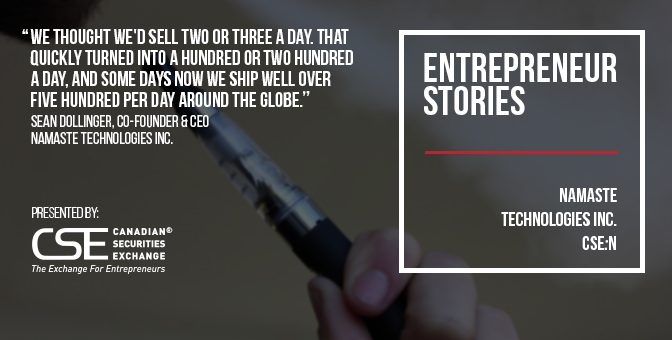The main revenue-producing component of Global UAV is its services division, consisting mainly of photogrammetry and geophysical surveying, but it offers a full-service package in the field of unmanned aerial vehicles (UAVs)
Global UAV Technologies (CSE:UAV) is one of the few listed operators in the fast-growing field of unmanned aerial vehicles (UAVs).
Formed just more than a year ago, Global UAV has quickly merged complementary businesses, allowing it to be a “one-stop shop” for those requiring UAV – or “drone”, if you prefer – services and for those who want to offer their own drone services.
The group has been assembled quickly through acquisition. The focus has been on buying companies with proven technologies that provide cash flow. As a result, unlike many nascent technology companies, it is already earning revenues, including a modest profit in the third quarter of 2017.
Admittedly, those revenue and profit numbers are small at the moment, as might be expected of a company capitalised at less than C$20mln. With revenues rising rapidly and a high-margin business model, however, there is every reason to believe the stock is readying for take-off.
Using drones to provide information on the physical properties of a land mass
One of the group’s subsidiaries, Pioneer Aerial Surveys, is the industry leader in drone geophysics and field operations.
In simple English, the company’s drone service can provide information on the physical properties of a land area. This service is a more cost-effective operation than manned surveys and can reach places a manned aircraft or ground crews would find hard to access.
Pioneer Aerial’s UAV-MAG surveys are in high demand from mineral exploration and mining companies worldwide.
In a similar vein, Global UAV’s other services subsidiary, High-Eye Aerial Imaging, provides low altitude, high definition, LiDAR (light detection and ranging), aerial surveying, photography, videography and other aerial mapping services.
Again, mining companies are keen on this stuff, but so too are the construction, engineering and agriculture industries, to name a few.
The company manufactures its own drones
The company uses its own drones, designed and manufactured by its NOVAerial Robotics division.
Its flagship Procyon 800E helicopter is used by international customers and is considered one of the best UAVs in its class. The single-rotor helicopter style design of the Procyon provides higher payload capacities and longer flight times than a typical commercial-grade multi-rotor UAV.
As a small progressive company that keeps abreast of industry trends, Global UAV president James Rogers thinks their products and services will keep them “ahead of the pack.”
The company also has a division, UAV Regulatory Services, which provides an online service called Easy SFOC.
This service assists clients with the preparation of special flight operation certificates (SFOCs). These certificates are required for the operation of recreational and commercial drones in Canada.
“It can be a fairly complex process to apply for that [an SFOC], so UAV Regulatory essentially offers a consultancy service to consumers who are interested in starting their own business. We can guide them through the regulatory requirements to help them get their licenses,” explained Michael Burns, CEO of Global UAV.
Together, these four businesses within Global UAV provide a fully integrated profile of manufacturing, services and regulatory compliance unique to the UAV industry and its customers.
“Right now, the main revenue-producing component of Global UAV is our services division, consisting mainly of photogrammetry and geophysical surveying,” Burns explained.
“The geophysical surveying services have been very lucrative for us. We have been the leader in this commercially since 2014 when we really brought this technology to market. We set ourselves up as a commercial supplier of the UAV-MAG services through Pioneer Aerial,” Burns continued.
“We’re able to offer to our customers either a full-service package, where they can hire us to come and do the work, or we can also do a sale. If a customer would like to purchase the equipment and get set up as a user, we can sell them a drone, train the customer and set them up with all the regulatory framework.” Burns added that it is a very attractive model for small companies.
The top line is heading higher – rapidly
A chart of quarter-by-quarter sales for Global UAV shows the sort of vertical take-off one might expect from the company’s drones.
In the first quarter (the three months to January 31), sales were C$22,386; in the second quarter they soared to C$181,204, and in the third, they rose to C$333,529.
The third quarter – to the end of July – saw the company move into the black, with net income of C$154,956.
A NOVAerial drone typically sells for US$30,000 to US$40,000. Therefore, the company does not exactly need the manufacturing clout of General Motors to keep that top line moving north at a rate of knots, especially as a high-margin business that gets the bottom line heading in the right direction as well.
According to auditing and consulting services provider PwC, “the drone revolution is disrupting industries ranging from agriculture to film-making”.
PwC values the emerging global market for business services at US$127bn, with infrastructure (US$45.2bn) and agriculture (US$32.4bn) the two biggest markets, while mining, where Global UAV is already strong, is valued at US$4.3bn.
In conclusion, the market opportunity is enormous. As James Rogers observed, however, North America is not awash with listed pure-play UAV companies, with big names such as Facebook, Google, Amazon and Boeing certainly having their fingers in the pie.
“Global UAV offers a ground floor entry opportunity to get into the drone sector.”
This story was originally published at www.proactiveinvestors.com on March 2, 2018 and featured in The Public Entrepreneur.Learn more about Global UAV Technologies at https://www.globaluavtech.com/ and on the CSE website at http://thecse.com/en/listings/technology/global-uav-technologies-ltd.



